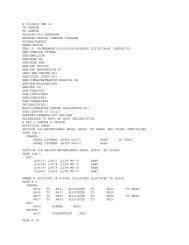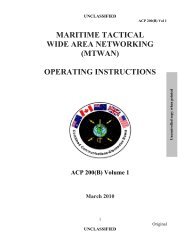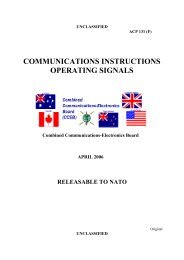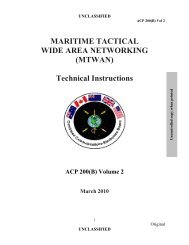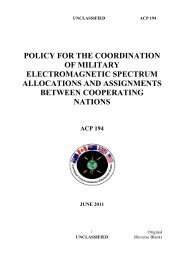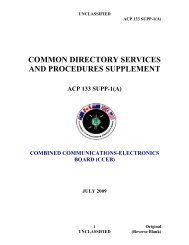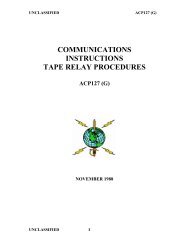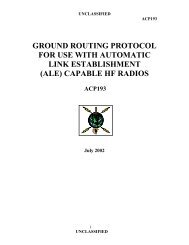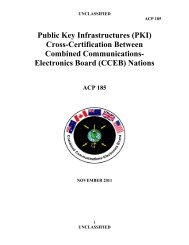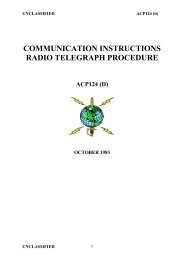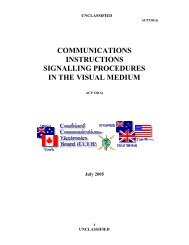ACP 201
ACP 201
ACP 201
You also want an ePaper? Increase the reach of your titles
YUMPU automatically turns print PDFs into web optimized ePapers that Google loves.
Uncontrolled Copy When Printed<br />
CHAT MESSAGE FORMAT<br />
UNCLASSIFIED<br />
<strong>ACP</strong> <strong>201</strong><br />
303. MNTG chat is conducted using plaindress, or abbreviated plaindress message<br />
format. Like other forms of Allied military messaging, each chat message transmitted will<br />
have three parts, these being the heading, the text and the ending. Where necessary the text<br />
can be separated from the heading and ending by the use of the prosign ―//‖, equivalent to the<br />
proword ―break‖.<br />
a. Heading:<br />
(a) The heading precedes the text and usually consists of called and calling<br />
stations. It will normally only identify action addressees, although it<br />
may include information and exempted addressees. The standard Allied<br />
method of establishing and conducting combined communications is the<br />
call sign or address designator of the station(s) called, followed by the<br />
call sign of the calling station and separated by the prosign ―DE‖ or the<br />
Proword ―THIS IS‖.<br />
Examples:<br />
ANZ de XJ<br />
b. Text:<br />
W this is XJ<br />
(b) A station or address designator may be classed as any combination of<br />
characters or pronounceable words designated for use in message<br />
headings to identify a command, authority, unit or communications<br />
facility, or to assist in the transmission and delivery of messages. Two<br />
letter Warfare Commander identifiers (eg XJ) or three letter abbreviated<br />
ship names ie USS HARRY S TRUMAN = HST may also be used;<br />
(c) The heading may also identify the precedence of the message, date time<br />
group and any other additional requirements such as relay<br />
responsibilities.<br />
(a) In addition to expressing the originator's thought or idea, the text may<br />
also contain such internal instructions as are necessary to indicate the<br />
requirement for special handling or acknowledgement;<br />
(b) The text may be separated from the heading and ending by the use of two<br />
oblique slants ―//‖ meaning Break. This immediately precedes and<br />
follows the text.<br />
c. Ending:<br />
(a) The Message ending includes:<br />
3-3 Original<br />
UNCLASSIFIED<br />
(Reverse Blank)



